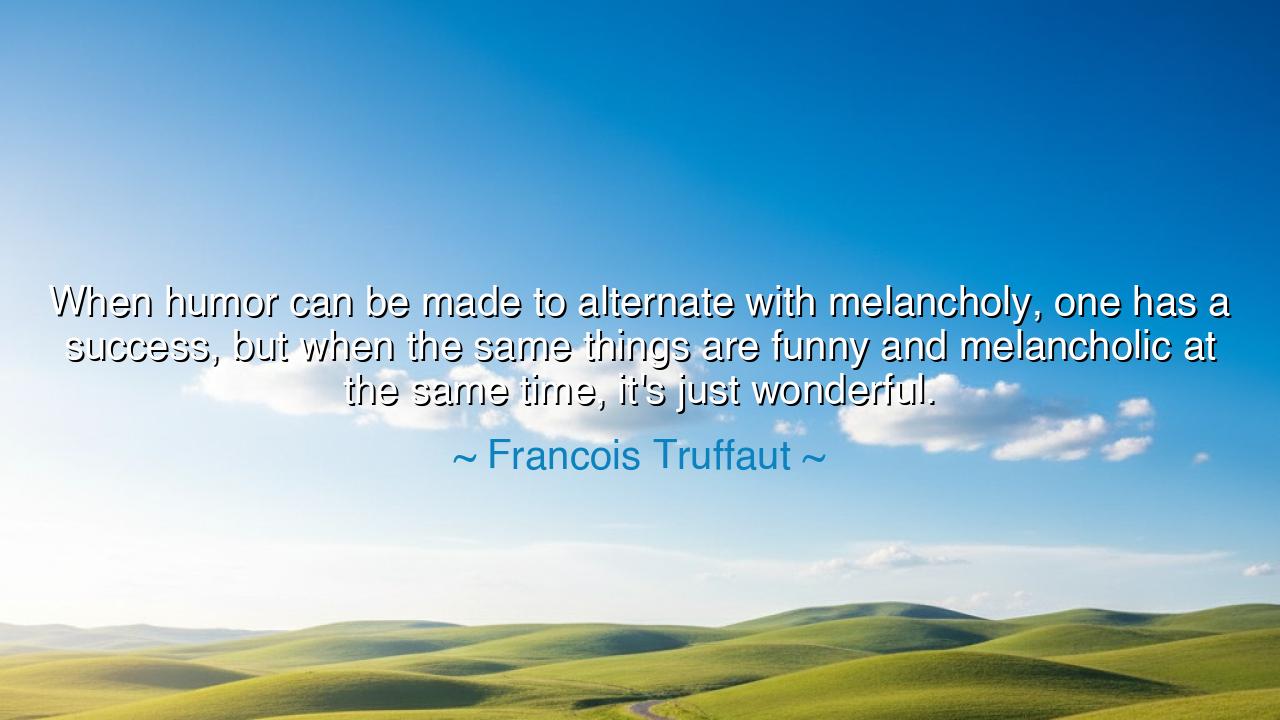
When humor can be made to alternate with melancholy, one has a
When humor can be made to alternate with melancholy, one has a success, but when the same things are funny and melancholic at the same time, it's just wonderful.






In the words of François Truffaut, “When humor can be made to alternate with melancholy, one has a success, but when the same things are funny and melancholic at the same time, it’s just wonderful.” These words, spoken by a poet of cinema, reveal the secret alchemy of the human soul — that life’s deepest beauty is found not in pure joy or pure sorrow, but in the mysterious place where they intertwine. Truffaut, who shaped the French New Wave with films that breathed with both laughter and pain, speaks here as an artist and as a sage. His insight reaches beyond film; it touches the heart of existence itself. For it is only when we can see humor within sorrow, and sorrow within humor, that we begin to understand what it means to be fully alive.
Truffaut, the orphaned dreamer turned filmmaker, knew the fragile balance of emotion better than most. His own life was marked by loneliness and longing, yet he used that sadness to infuse his art with tenderness. When he says that humor and melancholy together are “wonderful,” he speaks of truth, not technique. The alternating of laughter and tears — as he calls “success” — is but imitation of life’s rhythm. But when the same moment holds both, when we laugh and ache at once, when beauty and loss occupy the same breath — that is not performance, but revelation. That is art, and it is also truth.
This paradox is as old as storytelling itself. The ancients, in their wisdom, did not separate tragedy from comedy as rigidly as we do today. In the plays of Sophocles and Euripides, humor and sorrow walked hand in hand; the clown and the hero shared the same stage. The Greeks understood that human life was not composed of separate emotions, but of shifting shades, each illuminating the other. Laughter was sacred not because it denied pain, but because it redeemed it. It was the divine spark that flickered even in darkness — the smile of the soul that endures through tears. Truffaut inherited this ancient spirit and clothed it in the light and shadow of cinema.
Consider his film The 400 Blows, a tale drawn from his own youth. It follows a boy who dreams of freedom yet is caged by misunderstanding and neglect. There are moments of humor — small rebellions, childish joys, mischief — that make us laugh softly, even as our hearts break for him. This is the magic Truffaut describes: the same moment, both funny and melancholic, both sweet and sorrowful. We laugh not because it is light, but because it is true — because we recognize ourselves in the boy who both suffers and smiles. In that recognition, we are healed, for the laughter that arises from compassion is the most human sound of all.
To perceive humor and melancholy together is to achieve emotional wisdom. It is to see the wholeness of life, to accept that joy and pain are not opposites, but partners in a divine dance. Truffaut teaches that great art — and indeed, great living — does not shy away from complexity. The shallow laugh that denies sadness is hollow, and the sorrow that refuses to laugh is despair. But when both exist together, when the heart can cry and laugh at once, it transcends duality and touches eternity. The poet, the artist, the wise soul all strive to live in that delicate middle place — where laughter softens the ache, and sadness deepens the joy.
This truth can be seen also in the life of Charlie Chaplin, whose films embodied Truffaut’s philosophy before the words were spoken. Chaplin’s Tramp is comic in his clumsiness, yet tragic in his solitude. We laugh as he struggles to keep pace with the gears of industry, yet behind that laughter is an ache for all humanity — a silent cry for dignity in a world that grinds the soul. Chaplin, like Truffaut, knew that laughter born from compassion is not the opposite of sorrow, but its twin. His genius was not that he made us laugh or cry, but that he made us do both at once — and in doing so, reminded us of our shared humanity.
So let the lesson be this: seek the harmony of opposites within yourself. When life wounds you, do not close your heart; find the light that flickers even in the pain. When you laugh, remember that joy, too, is fragile, and that its beauty lies in its impermanence. The one who can embrace both laughter and sorrow at once becomes whole. Such a soul no longer fears loss or change, for they have learned that within every ending there is humor, and within every jest, a hint of longing.
Practical teaching: When you encounter sadness, do not flee from it — listen for the quiet humor that life hides within your suffering. When you are joyful, let humility temper your laughter, for every joy carries a trace of melancholy that keeps the heart gentle. Watch a film, read a poem, or look upon the world and ask: Where do laughter and sorrow meet? In that place lies truth, compassion, and art. For as François Truffaut knew, the greatest beauty of all is not found in one emotion alone, but in the sacred moment when humor and melancholy become one, and the soul, awakened, smiles through its tears.






AAdministratorAdministrator
Welcome, honored guests. Please leave a comment, we will respond soon